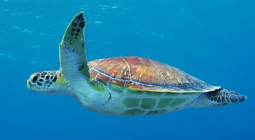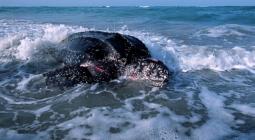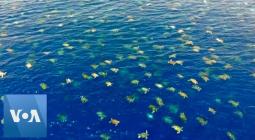‘It’s hugely moving’: sea turtle nests in Greece reach record numbers
Conservationists celebrate as efforts to save the Caretta caretta sea turtle, which has existed for 100m years, pay off
After nearly a quarter of a century observing one of the world’s most famous sea turtle nesting grounds, Charikleia Minotou is convinced of one thing: nature, she says, has a way of “sending messages”.
Along the sandy shores of Sekania, on the Ionian island of Zakynthos, what she has seen both this year and last, has been beyond her wildest dreams. The beach, long described as the Mediterranean’s greatest “maternity ward” for the Caretta caretta loggerhead sea turtle, has become host to not only record numbers of nests, but record numbers of surviving hatchlings as the species makes an extraordinary resurgence.
“The message sea turtles are sending is very clear,” said Minotou, who coordinates the WWF programme in the protected area. “And that is the measures we have taken over the past 25 years to ensure conditions are right for the marine turtles to nest here are working … It’s fantastic.”
One of the oldest living species, sea turtles are believed to have existed for more than 100m years. Although highly migratory – over a lifetime, the reptiles cross thousands of miles of seas and oceans – female turtles always return as mature adults, about 20 to 25 years later, to the habitat where they were born to lay eggs. It is a reproductive cycle that happens with perfect synchronicity. In Sekania and other nesting grounds in Zakynthos and around Greece, turtles tagged at birth by conservationists a quarter of a century ago are now reappearing to nest.
“It’s hugely moving,” says Minotou, a sustainable development expert who highlights the importance of technological advances, including the installation of CCTV cameras, in helping to ward off seagulls, ghost crabs and other predators.
“This year more than 1,200 nests have been recorded in Sekania, which is one every 50cm of beach. An amazing number.”
From Spain in the west to Cyprus in the east, the Mediterranean has witnessed a record rise in sea turtle nesting – testimony to the painstaking efforts of environmentalists determined to save an ancient mariner that not that long ago was on the verge of extinction. Only one in 1,000 turtle hatchlings makes it to adulthood, making the turnaround even more remarkable.
In Greece, which hosts 60% of Caretta caretta nests, the rebound has been phenomenal: from an average of 5,000 to 7,000 nests per year, since 2023 over 10,000 nests have been recorded annually, according to Archelon, the Sea Turtle Protection Society of Greece. “Throughout the 2000s, we were registering annual declines of about 6% on Crete, for example,” said Dr Aliki Panagopoulou, research coordinator for Archelon, the Sea Turtle Protection Society of Greece. “Now we are looking at a dramatic increase in nest numbers, the result of decades of conservation efforts. Our strategy has always been to make sure that as many hatchlings as possible get to the water and are recruited to the population.”
Thirty years ago, before the creation of a state-funded marine park on Zakynthos – the country’s biggest sea turtle nesting ground after the bay of Kyparissia in the Peloponnese – Greek authorities appeared oblivious to the plight of a species whose survival is now widely recognised as vital for marine ecosystems and the region’s ecological biodiversity.
Few have more vivid memories of the dangers the creatures once faced than Lily Venizelos, who founded the UK-based Mediterranean Association to Save the Sea Turtles (Medasset) in the 1980s.
The doughty campaigner, now in her 90s, spent years lobbying successive Greek governments to legislate policies to protect Caretta caretta from the then nascent threat of tourism and other perils posed by speedboat propellers, beach furniture and human activity in marine turtle habitats, conservationists say.
“I spent years when they were endangered running around different ministries with pieces of paper because back then no one cared to listen,” she recalled. “It’s been the most wonderful news, at my age, to find out that the Caretta caretta are no longer so threatened, but it’s crucial protective measures continue to be enforced. One false move and everything could be lost.”
The record number of tourists visiting Greece – by 2028 the country aims to attract 40 million holidaymakers, nearly four times its population – and the appeal of travel companies advertising “last-chance tours” to sites threatened by climate change and overtourism were “catastrophic,” she said.
“On the one hand, the EU wants to protect the species and, on the other, organisations are taking tourists on these ‘last chance’ tours,” she lamented. “It makes no sense at all.”
From the outset, Medasset has focused on the plight of marine turtles across the Mediterranean, and its crammed fourth-floor offices in downtown Athens have become a focal point for similar organisations from Sardinia to Albania, from Turkey to Syria, Lebanon, Egypt and Libya. In more recent years, as awareness has grown, so, too, has a mission to win a place for sea turtles “in the hearts of the public”. The NGO has expanded its scientific research and education programmes for both young and elderly people in schools and care homes.
But campaigners also warn against complacency. The climate emergency, overfishing, pollution and the ever growing prevalence of discarded plastics are new dangers. All too often, they say, officials cite the turnaround to avoid further action in countries such as Greece, where tourism is the engine that drives the economy.
“There’s no doubt that across the Mediterranean, the increase in the Caretta caretta population is a nature-based reaction to all the conservation efforts of NGOs over the last few decades,” said Nadia Andreanidou, Medasset’s programmes and policy officer. “But now, more than ever, we need the support of the government to implement the laws we have pushed for if we are to build on the momentum and keep this extraordinary animal out of danger. The threats are still very much there, and it could all so easily unravel.”
Cover photo: A loggerhead turtle (Caretta caretta) off Elafonissos island in Greece, where the rebound in population has been phenomenal. Photograph: Giacomo Augugliaro/Getty Images






